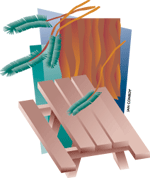REDWOOD RENOVATION
We at the Arboretum were delighted to see the Campus Views piece by Joe Mills on his affection for the arboretum’s redwood grove [spring 2003]. I would like to let your readers know that the redwood grove is currently being renovated, thanks in part to generous donations from members of the class of 2000, who designated their senior gift to improve and conserve what many consider their favorite place on campus.
We began the project by hiring consulting arborist John Lichter (a graduate of the environmental horticulture master’s program) to evaluate environmental conditions and tree health in the grove. The design for the renovation project was created by landscape architect Ron Lutsko, also a UC Davis alumnus, who is known for his expertise with California native plants and his understated naturalistic designs.
Volunteers from the Rotary Club of Davis will build new picnic tables and benches for the garden. We will install a series of educational signs, a gathering circle with low seating walls and a small fountain. Construction is due to be completed by the end of September.
For information on the restoration project, your readers may call the arboretum at (530) 752-4880.
Diane Cary
UC Davis Arboretum
MIDDLE EAST ASIAN
I look at those beautiful faces in the article [“Between Two Worlds,” summer 2003] and I see that not one of them resembles my children who are also Asian, but from Iran.
I do not understand why Asians of the Pacific Rim are called Asians and Asians of the Middle East are not. Are those of us of the United States the only North Americans? Are the peoples of Western Europe the only Europeans?
So much of what is said in the article “Between Two Worlds” applies to those who come from the other Asia.
Mary Kent, mother of two Asian UC Davis graduates
via e-mail
Anita Poon, student services officer, notes that the university often follows federal racial category systems and that, on campus, most of the Arab and Persian students identify themselves as Middle Eastern. She says, “Asian American is a political term that has been fluctuating over the three decades of its existence. Some Iranians identify themselves as Asian American, while others do not. Indians, Pakistanis, Bangladeshis and other South Asians have historically identified as Asian American because of U.S. government policies that grouped them with other Asian Americans. The Census and the UC data collection materials list Arabs and Persians as ‘white.’ All of this is changing as the critical race landscape has been changing post-2001. I believe there will be an ‘Arab’ category on the 2010 Census.”
ALIEN ERADICATOR
I read the spring 2003 edition article “The Aliens Among Us” with both particular interest in the topic and appreciation that you highlighted faculty and staff and their respective efforts to fight invasive species.
In particular, I’d like to thank Dr. Susan Williams for her efforts to advance California public policy in trying to eradicate Caulerpia taxifolia and eight other problematic species of this “killer algae.”
Assemblyman Tom Harman introduced legislation that prohibits the sale, possession, transport, gift and release of this predator, except for scientific research as authorized by the Department of Fish and Game. The bill passed and was then signed into law. This is largely attributable to the written and verbal testimony by Dr. Williams and the wealth of background information she made available to us for our education and for distribution to other members of the legislature.
On behalf of the assemblyman, I wanted to extend public thanks to Dr. Williams.
Peter S. Crandall ’79
via e-mail
WAR WOUNDS
There still is no shame, is there?, about what Vietnam veterans are subjected to. This, I must say, almost took the cake. Surely your editors must know how any references to “baby-killers” [summer 2003, “World at War”] upset veterans more than anything else. I served stateside, not in-country, but I was shocked at the casual, even proud, reference to Mr. Holcombe’s poster about dead babies. If he is not capable of apologizing after all these years or if he does not think it necessary or advisable, then the editors should apologize for including that, at least without some sort of warning of what would occur in this article.
Mary Garvey, veteran
via e-mail
David Holcombe responds: The Vietnam War tore the nation apart and left deep wounds, some of which are not yet healed. Re-igniting the violent confrontations of that war, even on paper, serves no useful purpose. A pile of dead babies symbolizes what all wars produce, a massacre of the innocents.
CLARIFICATIONS
A story in the summer issue regarding the UC Davis Herbarium omitted a co-author of the Weed Identification Handbook. Bill Fischer of UC Cooperative Extension is the senior author of the publication, assisted by former herbarium curator and principal museum scientist June McCaskill.
In “Sex Ed—Keep on Talkin’” in the summer issue, we stated that hepatitis B is incurable. David Mize, B.S. ’89, a fellow in gastroenterology and hepatology at the Penn State Milton S. Hershey Medical Center pointed out that is not always the case: Approximately 10 percent to 15 percent of people who contract hepatitis B will clear the virus spontaneously, he notes, and drugs have proven effective in treating many of those who develop chronic hepatitis B.

|

